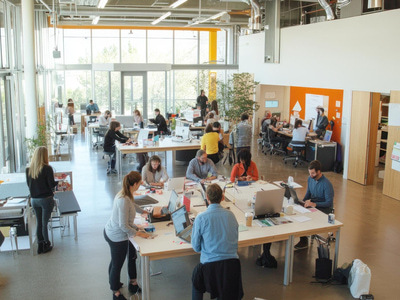New Designs for School
A Middle School Student’s Take on Personalized Learning
Topics

We’ve all had the experience of truly purposeful, authentic learning and know how valuable it is. Educators are taking the best of what we know about learning, student support, effective instruction, and interpersonal skill-building to completely reimagine schools so that students experience that kind of purposeful learning all day, every day.
To get a real idea of how personalization has changed the student experience, this middle school leader interviewed 8th grader Jonathan Reyes.
Middle school students are unexpected, dynamic, bold, and up for a challenge. I have been connected to middle school since my start with Distinctive Schools. When I think back to my first few years as a teacher with Distinctive, my students were compliant. They showed up, listened to me, and took the test whenever I told them to. My students performed well on tests, but their growth plateaued as their middle school years progressed. It was evident that our middle schoolers were ready for something more. Three years ago, we began the design thinking process—it was time to innovate.
Since that time, our middle school model has changed dramatically. We began using the Summit Learning Platform last year to accelerate our personalized learning practices. It has been an incredible journey and we continue to iterate and analyze and change and fix, but one thing that has remained the same is the deep level of engagement and self-direction our students have made within the course of two years.
I wanted to get a real idea of how personalization has changed the student experience, so I decided to go to the source. I interviewed Jonathan Reyes, one of our current 8th graders. He has been a part of the CICS Bucktown school community throughout middle school, is a Student Ambassador, and in true middle school fashion, he gives a dose of “realness” whenever given the opportunity.
Before personalization, curriculum and resources were outdated and irrelevant to our current world. Personalization brought an immediate upgrade through technology.
“There were a lot of presentations, handouts, and packets that were old school,” Jonathan explained. “Now, we have computers.”
While the infusion of technology was an immediate, obvious change students felt, the less obvious changes in classroom dynamics is where the true power of personalization is seen.
“Teachers would just talk to the the class and now we have one-to-one experiences with our teachers,” Jonathan said. “If you knew something, you couldn’t move forward. You had to stick with everyone. We would do some projects, but they weren’t really meaningful. It just felt like work for me to do; they weren’t something that I would remember. I also didn’t know mastery, but now I know what each score means and what I need to do.”
Moving at one’s own pace has been a game changer with our middle school students. Yes, teachers do create deadlines—we have due dates in the real world! And, yes, students must show mastery of content knowledge at a recommended pace. However, having the option of moving forward at different points in time has increased the level of engagement and perseverance in our middle school. When I asked Jonathan, “What’s different now?” he responded,
“Now, I don’t have to wait for my class. I can work at my own pace. I can pass, move forward, and not have to wait. If you are getting behind, teachers help and identify supports. I am able to see my scores and grades in real time. I like that I can see the rubric and what I have to work on, fix, or keep in mind for my next project.”
He continued to talk about another portion of his day: mentoring. Jonathan explained,
“We also have mentoring now. My mentor and I talk about what’s going on in school and out of school and I get advice on what I need to do to be successful based on my progress in my courses. I value this because without it, I might not be on track. I need to make sure I’m ready to speak to my goals and create next steps for them.”
Before personalized learning, we didn’t mentor students. We now have embedded dedicated times in the students’ schedule where they meet with their mentor (a teacher, staff member, or administrator) once a week. Both individuals review progress and create attainable goals. Mentors hone in on the habits of success during these conversations to frame goal setting. Most importantly, the mentor becomes the student’s biggest advocate and also supports them with social and emotional growth.
With change comes a great deal of dealing with the unknown. When you add 225 middle schoolers into the mix, the recipe can be compromised. The first few months in taking a personalized learning approach were a bit rocky for both the students and the teachers. However, the curriculum, resources, and mentoring started to click as we noticed students take more ownership of their learning and were getting the hang of becoming more independent. This is not to say that personalized learning is a walk in the park for our kids. Here’s Jonathan’s take:
“I am becoming more independent, but there are times when I do need help. I just need to make sure that I am taking the right steps that support my learning. Before I was good at school, but I wasn’t on top of my work like I am now. I really like having independence, but again with independence comes responsibility. You need to be responsible or else you might fall behind and it makes it that much harder to get back on track. With this model, I’m more engaged. I have a mentor. I am able to work at my own pace. If I know what I’m doing, I’m able to pass my assessments, move forward, and continue to go.”
Jonathan’s final words stood out to me:
“There’s no stop to what I’m learning. My teachers now give me options on how I can go about learning because they know exactly what I need.”
Personalized learning has allowed our students to understand who they are as a learner and to internalize the habits of success. This dynamic combination will propel our students to achieve their hopes and dreams and give back to the ever changing world around them.




